

Isaac Newton. I do not know what I may appear to the world, but to myself I seem to have been only like a boy playing on the sea-shore, and diverting myself in now and then finding a smoother pebble or a prettier shell than ordinary, whilst the great ocean of truth lay all undiscovered before me.
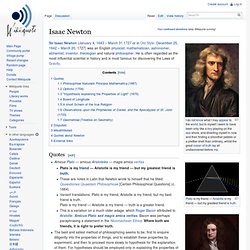
Sir Isaac Newton (January 4, 1643 – March 31 1727 or in Old Style: December 25, 1642 – March 20, 1727) was an English physicist, mathematician, astronomer, alchemist, inventor, theologian and natural philosopher. He is often regarded as the most influential scientist in history and is most famous for discovering the Laws of Gravity. Quotes[edit] I frame no hypotheses. Christ comes as a thief in the night, & it is not for us to know the times & seasons which God hath put into his own breast. To explain all nature is too difficult a task for any one man or even for any one age... Truth is ever to be found in simplicity, and not in the multiplicity and confusion of things. I have studied these things — you have not. Timeline of classical mechanics.
History of classical mechanics. This article deals with the history of classical mechanics.
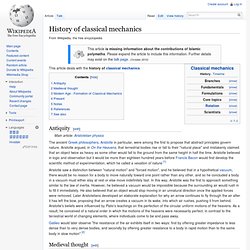
Antiquity[edit] The ancient Greek philosophers, Aristotle in particular, were among the first to propose that abstract principles govern nature. Aristotle argued, in On the Heavens, that terrestrial bodies rise or fall to their "natural place" and mistakenly claimed that an object twice as heavy as some other would fall to the ground from the same height in half the time. Aristotle believed in logic and observation but it would be more than eighteen hundred years before Francis Bacon would first develop the scientific method of experimentation, which he called a vexation of nature.[1] Aristotle saw a distinction between "natural motion" and "forced motion", and he believed that in a hypothetical vacuum, there would be no reason for a body to move naturally toward one point rather than any other, and so he concluded a body in a vacuum must either stay at rest or else move indefinitely fast.
Kinematics. The study of kinematics is often referred to as the geometry of motion.[7] (See analytical dynamics for more detail on usage.)
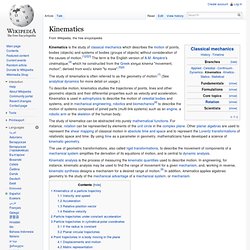
To describe motion, kinematics studies the trajectories of points, lines and other geometric objects and their differential properties such as velocity and acceleration. Kinematics is used in astrophysics to describe the motion of celestial bodies and systems, and in mechanical engineering, robotics and biomechanics[8] to describe the motion of systems composed of joined parts (multi-link systems) such as an engine, a robotic arm or the skeleton of the human body. The study of kinematics can be abstracted into purely mathematical functions.
For instance, rotation can be represented by elements of the unit circle in the complex plane. Other planar algebras are used to represent the shear mapping of classical motion in absolute time and space and to represent the Lorentz transformations of relativistic space and time. Kinetic theory. This article is about kinetic theory of gases.
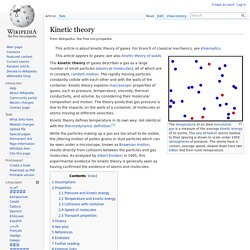
For branch of classical mechanics, see Kinematics. This article applies to gases; see also Kinetic theory of solids Kinetic theory defines temperature in its own way, not identical with the thermodynamic definition.[1] While the particles making up a gas are too small to be visible, the jittering motion of pollen grains or dust particles which can be seen under a microscope, known as Brownian motion, results directly from collisions between the particles and gas molecules. As analyzed by Albert Einstein in 1905, this experimental evidence for kinetic theory is generally seen as having confirmed the existence of atoms and molecules. Assumptions[edit]
Contact mechanics. Stresses in a contact area loaded simultaneously with a normal and a tangential force.
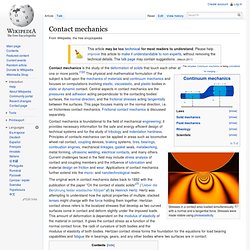
Stresses were made visible using photoelasticity. History[edit] When a sphere is pressed against an elastic material, the contact area increases. Classical contact mechanics is most notably associated with Heinrich Hertz.[4] In 1882, Hertz solved the contact problem of two elastic bodies with curved surfaces. This still-relevant classical solution provides a foundation for modern problems in contact mechanics. Heinrich Hertz. Heinrich Rudolf Hertz (German: [hɛʁʦ]; 22 February 1857 – 1 January 1894) was a German physicist who first conclusively proved the existence of electromagnetic waves theorized by James Clerk Maxwell's electromagnetic theory of light.

Hertz proved the theory by engineering instruments to transmit and receive radio pulses using experimental procedures that ruled out all other known wireless phenomena. The scientific unit of frequency – cycles per second – was named the "hertz" in his honor.[1] Biography[edit] Hertz's paternal grandfather, Heinrich David Hertz (originally named Hertz Hertz) (1797–1862), was a businessman, and his paternal grandmother, Bertha "Betty" Oppenheim, was the daughter of the banker Salomon Oppenheim, Jr. from Cologne.
Adhesion. Adhesion of a frog on a wet vertical glass surface.

Process of attachment of a substance to the surface of another substance. Note 1: Adhesion requires energy that can come from chemical and/or physical linkages, the latter being reversible when enough energy is applied. Note 2: In biology, adhesion reflects the behavior of cells shortly after contact to the surface. Note 3: In surgery, adhesion is used when two tissues fuse unexpectedly.[1] Surface energy[edit] Diagram of various cases of cleavage, with each unique species labeled.A: γ = (1/2)W11B: W12 = γ1 + γ2 – γ12C: γ12 = (1/2)W121 = (1/2)W212D: W12 + W33 – W13 – W23 = W132.
If the surfaces are unequal, the Young-Dupré equation applies: W12 = γ1 + γ2 – γ12, where γ1 and γ2 are the surface energies of the two new surfaces, and γ12 is the interfacial tension.